---「無限運動」のお話 ---

錯覚の解明・創作・利用への諸アプローチ 第15回 錯覚ワークショップ
(オンライン) 2021年3月2日(火)15:40-16:20
輝度変化による運動錯視(リバースファイなど)の再検討
---「無限運動」のお話 ---
2021年2月12日開設 抄録
警告: このページは本物の動画のページなので、長時間見続けないようにして下さい。ポケモン効果のようなフリッカー刺激は当然避けていますが、未知の危険要因もあるかもしれません。転載厳禁。

「扉を開けたまま走る電車」
停車中の電車が右に走行するように見える。
Copyright Akiyoshi Kitaoka 2021 (February 9)
.gif)
停車中の電車が左に走行するように見える。
.gif)
停車中の電車が浮上するように見える。
.gif)
電車が歩くように見える。
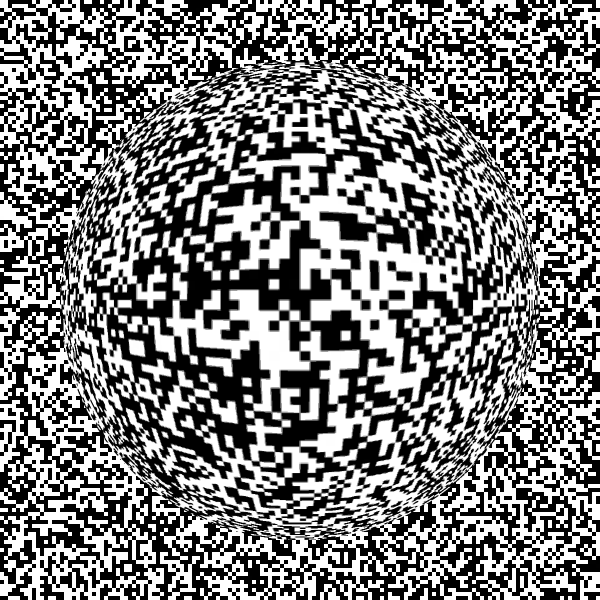
「無限膨らみ」
静止画4枚の繰り返しでできているが、リングは膨らみ続けて見える。
Copyright Akiyoshi Kitaoka 2021 (February 12)
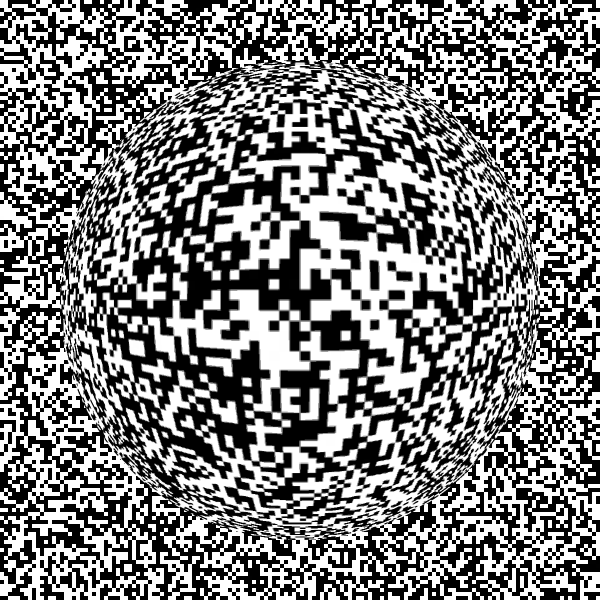
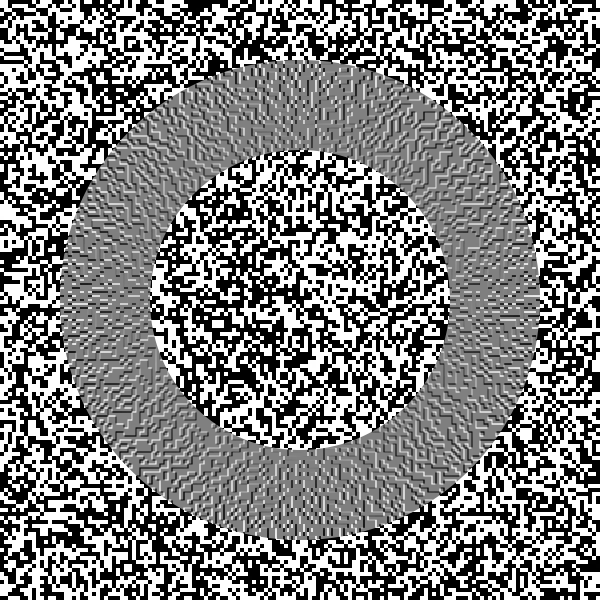
「無限回転」
静止画4枚の繰り返しでできているが、リングは時計回りに回転して見える。
Copyright Akiyoshi Kitaoka 2021 (February 10)
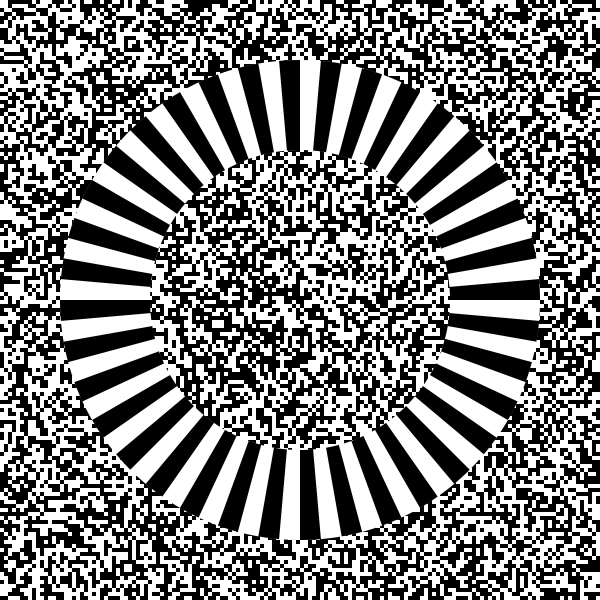
(縞バージョン)
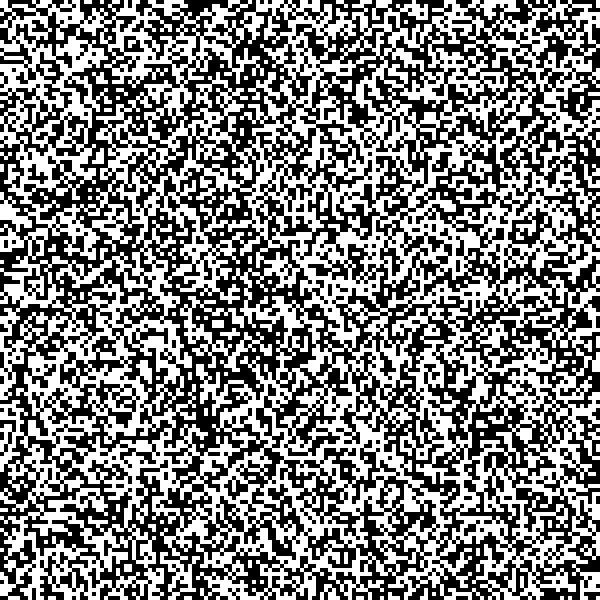
(円盤回転バージョン)
Copyright Akiyoshi Kitaoka 2021 (February 11)
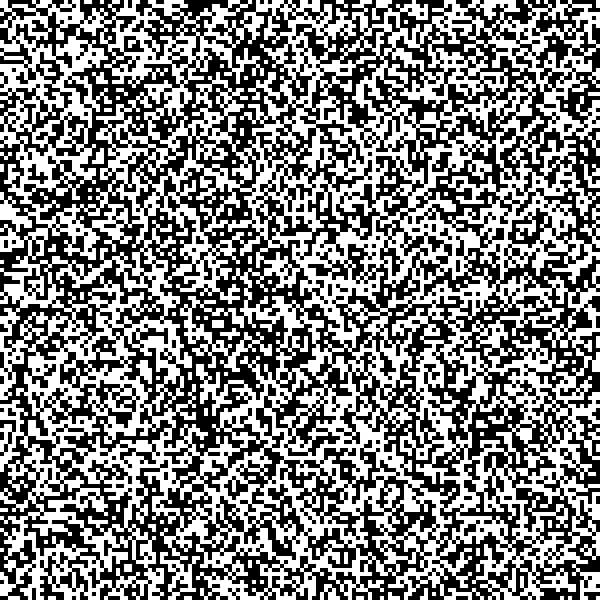
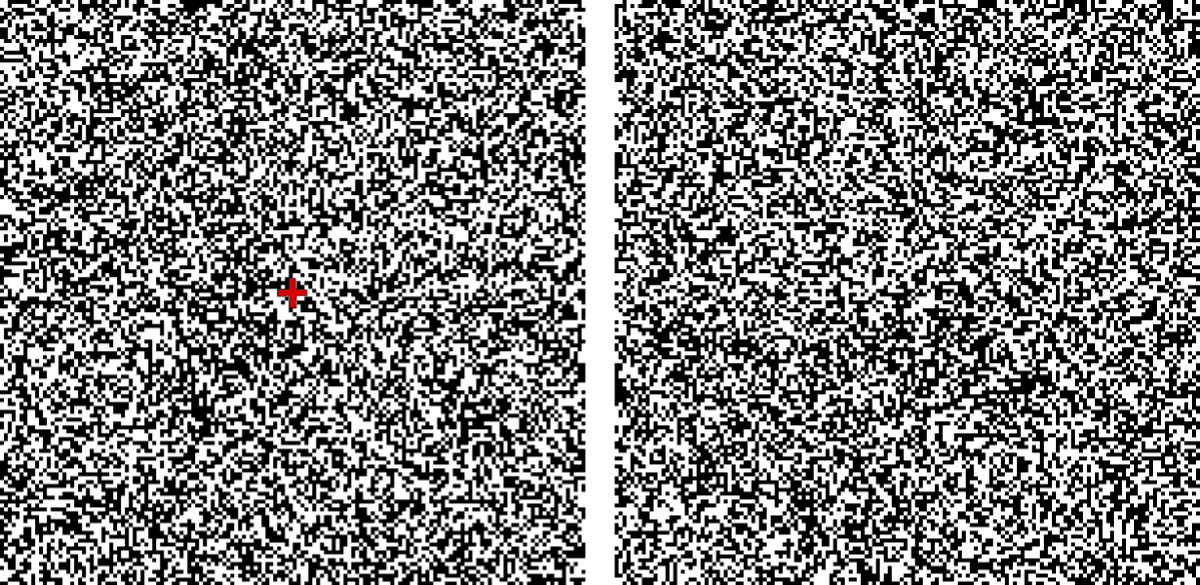
(運動残効確認用)
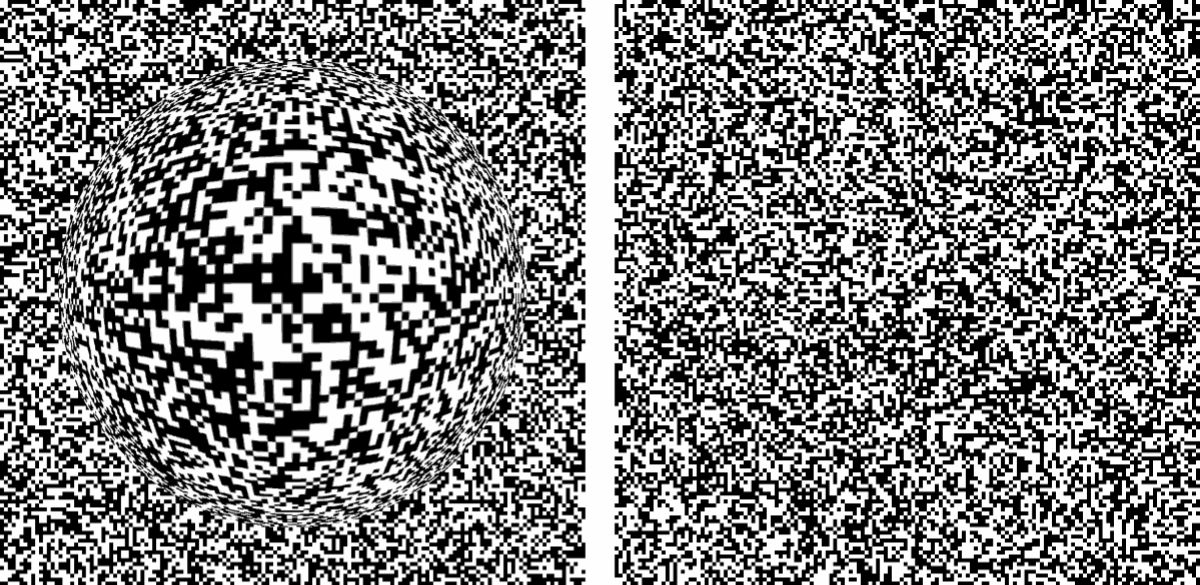
(運動残効確認用)
突然ですが回転させると大きさが変化して見えるリングを考案しました pic.twitter.com/4GgHO7LHeF
— じゃがりきん (@jagarikin) February 19, 2020
スーパー錯視ブラザーズ pic.twitter.com/bLkFhBOCeU
— じゃがりきん (@jagarikin) November 20, 2020
Hi Pinker pic.twitter.com/3KIW7TzVEb
— じゃがりきん (@jagarikin) January 10, 2021

50 ms/frame
「電車のシーンの8ストローク運動(すべてリバースファイ)デモ」
(反転画像は、オリジナルフレームのネガポジ反転)
この動画はたった8枚の画像でできているが、電車は常に進行しているように見える。
Copyright Akiyoshi Kitaoka 2020 (March 22)
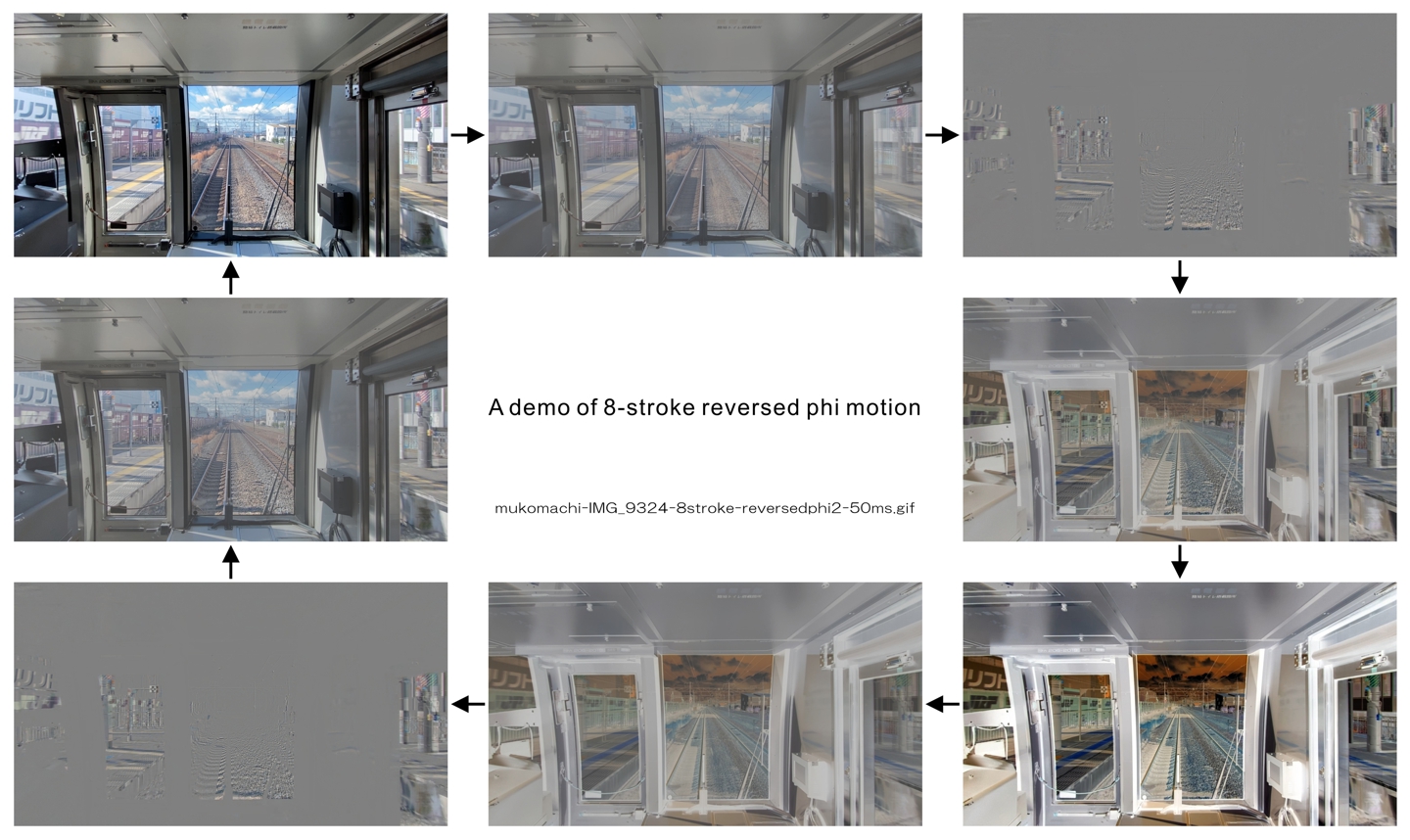

50 ms/frame
(反転画像は、オリジナル動画の2フレーム目)
Copyright Akiyoshi Kitaoka 2020 (March 22)

50 ms/frame
「電車のシーンの16ストローク運動(すべてリバースファイ)デモ」
(反転画像は、オリジナル動画の2フレーム目)
この動画は16枚の画像でできているが、電車は常に進行しているように見える。
Copyright Akiyoshi Kitaoka 2020 (March 22)

100 ms /frame
「電車のシーンの4ストローク運動(すべてリバースファイ)デモ」
(反転画像は、オリジナル動画の2フレーム目)
この動画はたった4枚の画像でできているが、電車は常に進行しているように見える。
Copyright Akiyoshi Kitaoka 2020 (March 22)
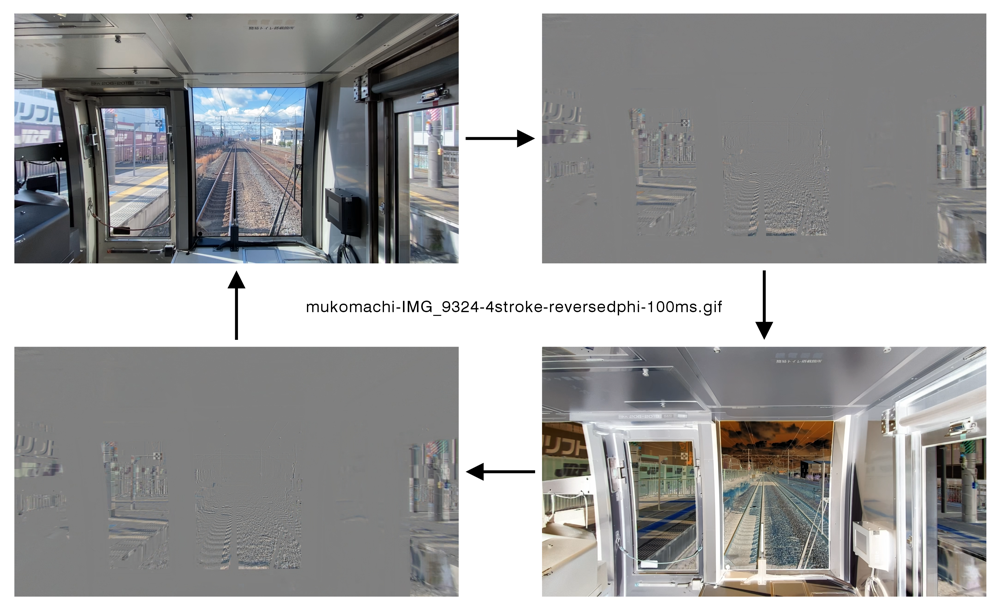

100 ms/frame
「電車のシーンの(マーザーの)4ストローク運動デモ」
この動画はたった4枚の画像でできているが、電車は常に進行しているように見える。
Copyright Akiyoshi Kitaoka 2020 (March 12)
Reference: http://www.georgemather.com/MotionDemos/FourstrokeMP4.html
Mather, G. and Murdoch, L. (1999) Second-order processing of four-stroke apparent motion. Vision Research, 39, 1795-1802.
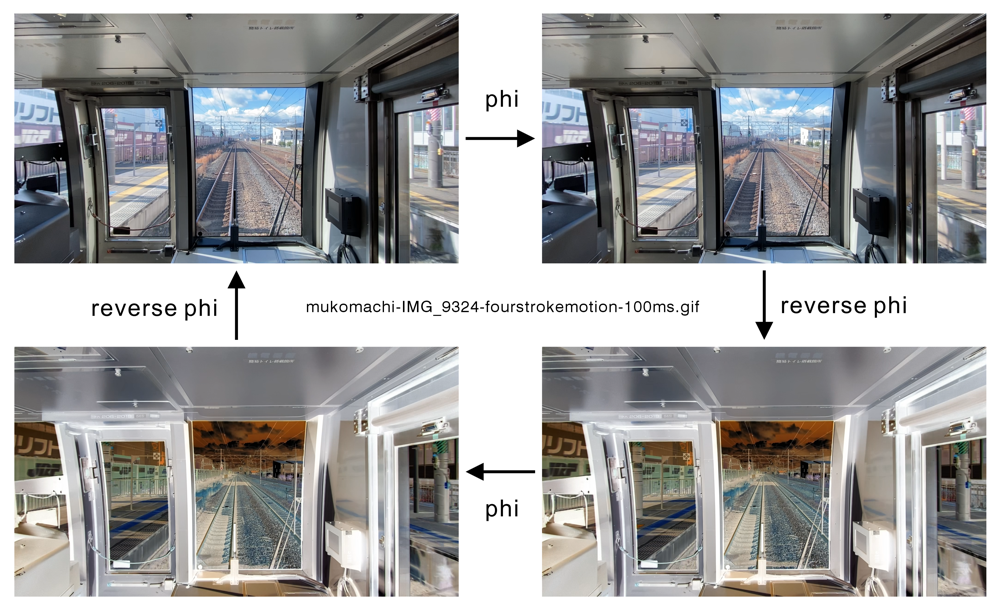
Differences in perceived speed pic.twitter.com/bwOeeAnKV8
— Akiyoshi Kitaoka (@AkiyoshiKitaoka) March 11, 2020
本講演で紹介する「無限運動」は以下のように作る。
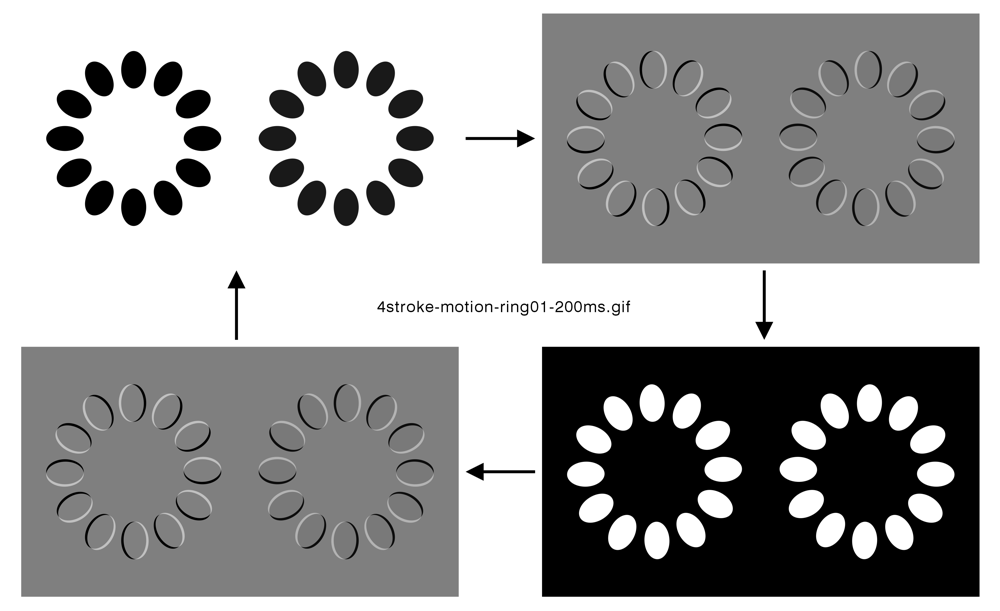
左上は1枚目の画像。右下は2枚目の画像をネガポジ反転させたもの。右下の画像では、左上の画像に比べて、左のリングは2度反時計回りに回転し、右のリングは2度時計回りに回転させている。右上と左下の画像は、左上と右下の画像の差分の画像である。
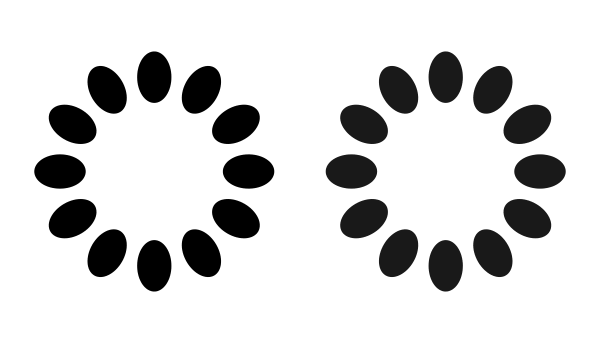
左のリングは反時計回りに、右のリングは時計回りに回転して見える。(200 ms / frame)
Copyright Akiyoshi Kitaoka 2021 (February 22)
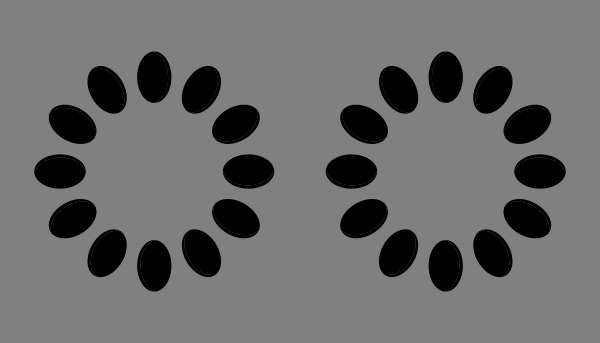
背景を灰色に固定しても、この錯視は見える。(200 ms / frame)
Copyright Akiyoshi Kitaoka 2021 (February 22)
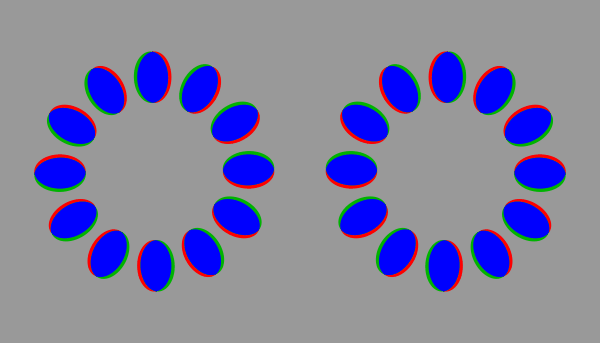
輝度の順番を変えずに色を付けても、この錯視は見える。(200 ms / frame)
Copyright Akiyoshi Kitaoka 2021 (February 22)
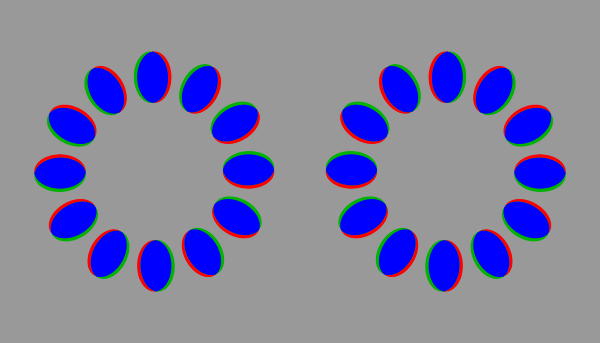
(100 ms / frame)
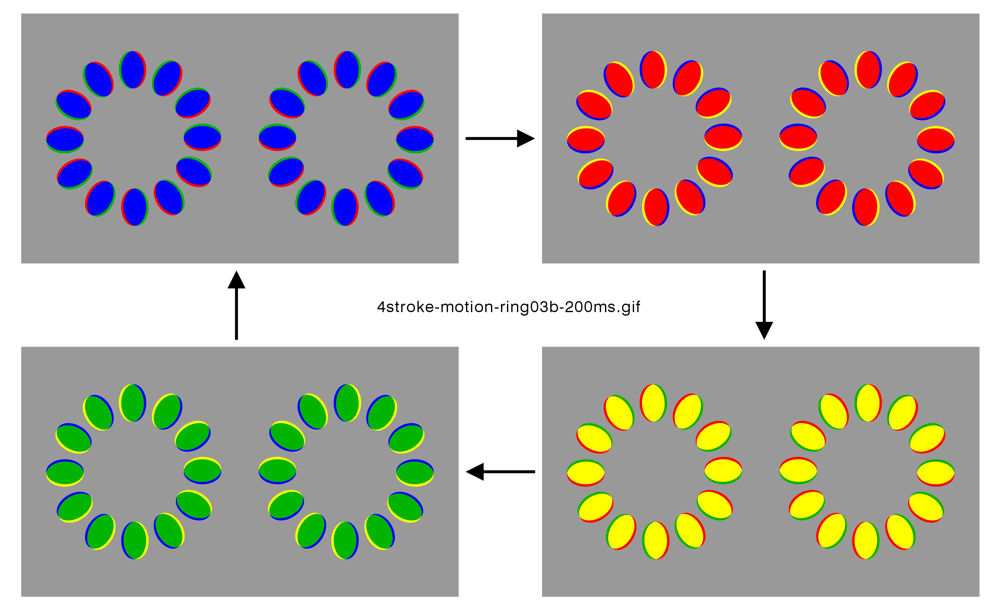
青は黒、黄は白、赤と緑は灰色に相当する。じゃがりきん氏の錯視作品を説明する原理である。ただし、じゃがりきん氏の作品では、色はなめらかに推移する。
Copyright Akiyoshi Kitaoka 2021 (February 22)
Hi Pinker pic.twitter.com/3KIW7TzVEb
— じゃがりきん (@jagarikin) January 10, 2021
p.s. 引用するべき論文を忘れておりました。
Flynn, O. F. & Shapiro, A. G. (2018). The perpetual diamond: contrast
reversals along thin edges create the appearance of motion in objects.
i-Perception, 9(6), 1–6.
https://journals.sagepub.com/doi/full/10.1177/2041669518815708
<2021/3/4>
The perptual diamond: The diamond remains fixed in one place but appears to move up, down, left, or, right. See how far away you can be from your screen before the effect goes away. From https://t.co/XRFKTtjOfm pic.twitter.com/af7BOUCvfC
— Arthur Shapiro (@agshapiro2) June 2, 2019
Q: この「無限運動」は何か?
A: リバースファイ(reverse phi or reversed phi)である。

「リバースファイ」と聞くと思い浮かべやすいリバースファイのデモ。左右のリングは、要素の楕円の位置のシフトという点では、ともに時計回りに回転しているが、右のリングは時計回りの回転に見えるが、左のリングは反時計回りの回転に見える。特に、周辺視で見た時にその傾向が強い。
Copyright Akiyoshi Kitaoka 2020 (April 9) (remade:February 23, 2021)
Anstis, S. M. (1970). Phi movement as a subtraction process. Vision Research,
10, 1411-1430.
https://www.sciencedirect.com/science/article/pii/0042698970900921

(50 ms / frame)
(オリジナルの)リバースファイ(reverse phi)のデモ
リングは右に回転したり、左に回転したりして見える。
Rings appear to rotate to and fro, though black or white arcs are stationary.
Copyright Akiyoshi Kitaoka 2020 (March 17)

(200 ms / frame)
Gregory, R. L. & Heard, P. F. (1983). Visual dissociations of movement, position, and stereo depth: Some phenomenal phenomena. Quarterly Journal of Experimental Psychology, A, 35, 217-237. https://journals.sagepub.com/doi/10.1080/14640748308402127

(50 ms / frame)
フェノメナル・フェノメナ(phenomenal phenomena)
リングは右に回転したり、左に回転したりして見える。
Rings appear to rotate to and fro, though black or white arcs are stationary.
Copyright Akiyoshi Kitaoka 2020 (March 19)

(50 ms / frame)
Kitaoka, A. (2006). Configurational coincidence among six phenomena: A comment on van Lier and Csathó (2006). Perception, 35, 799-806.
https://journals.sagepub.com/doi/10.1068/p5319b
Animation 1
Reversed phi movement (Anstis and Rogers 1975). There are four rectangles, each of which is flanked by thin lines that are dark or light. When the luminance of the rectangles decreases and that of the background increases accordingly, the upper two appear to converge in motion while the lower two appear to go apart in motion. On the other hand, when the luminance of the rectangles increases and that of the background decreases accordingly, the upper two appear to go apart in motion while the lower two appear to approach each other in motion. In sum, the direction of apparent motion is from the dark flank to the neighboring part that goes darkening or from the light flank to the neighboring part that goes brightening. Although the rectangles are aligned vertically, the apparent positional displacement occurs in the opposite direction to motion. If observers cross-fuse (uncross-fuse) the right and left rectangles, the upper rectangle appears to be in front of (behind) the lower one when they are dark.

Animation 2
The illusory motion investigated by Gregory and Heard (1983). This appearance is quite similar to Animation 1. The only configurational difference from the reversed phi movement is that the luminance of the rectangles is constant.

Animation 3
The illusory motion mentioned by Gregory and Heard (1983), in which the luminance of the rectangles dynamically changes while that of the surround is constant. This appearance is quite similar to Animations 1 and 2.

Animation 4
Phi movement (Anstis and Rogers 1975). For panel (a), dark stationary rectangles are placed on a bright stationary background. When the luminance of the right flank of each rectangle increases and that of the left flank decreases, the rectangle appears to shift leftward in motion as well as in position. Conversely, the luminance of the right flank decreases and that of the left flank increases, the rectangle appears to shift rightward in motion and position. If observers cross-fuse (uncross-fuse) the right and left rectangles, the fused rectangle appears to be in front (behind) when the right flank of the right rectangle are dark and the left flank of the left rectangle are dark. For panel (b), bright rectangles are placed on a dark background. In this case, phenomena are the reversal of panel (a).
(a) .gif)
Kitaoka-2006-Animation4(a).gif
(b) .gif)
Kitaoka-2006-Animation4(b).gif
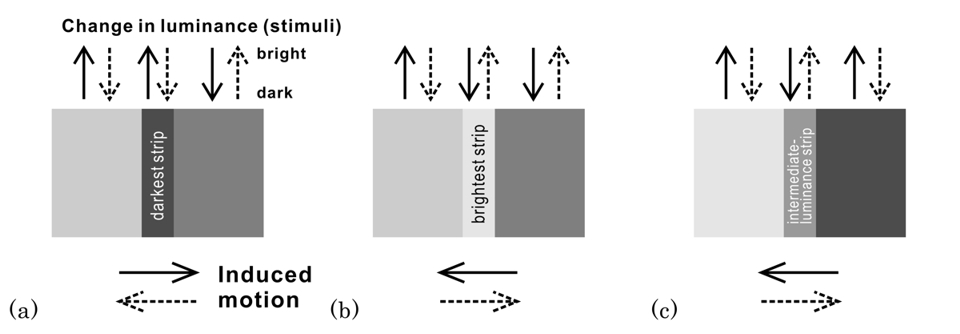
(a) and (b): reverse phi; (c) phi
Anstis, S. M. & Rogers, B. J. (1975). Illusory reversal of visual depth and movement during changes of contrast. Vision Research, 15, 957-961. https://www.sciencedirect.com/science/article/pii/0042698975902369

(50 ms / frame)
ファイ(phi movement)
リングは右に回転したり、左に回転したりして見える。
Rings appear to rotate to and fro, though black ellipses are stationary.
Copyright Akiyoshi Kitaoka 2020 (March 19)
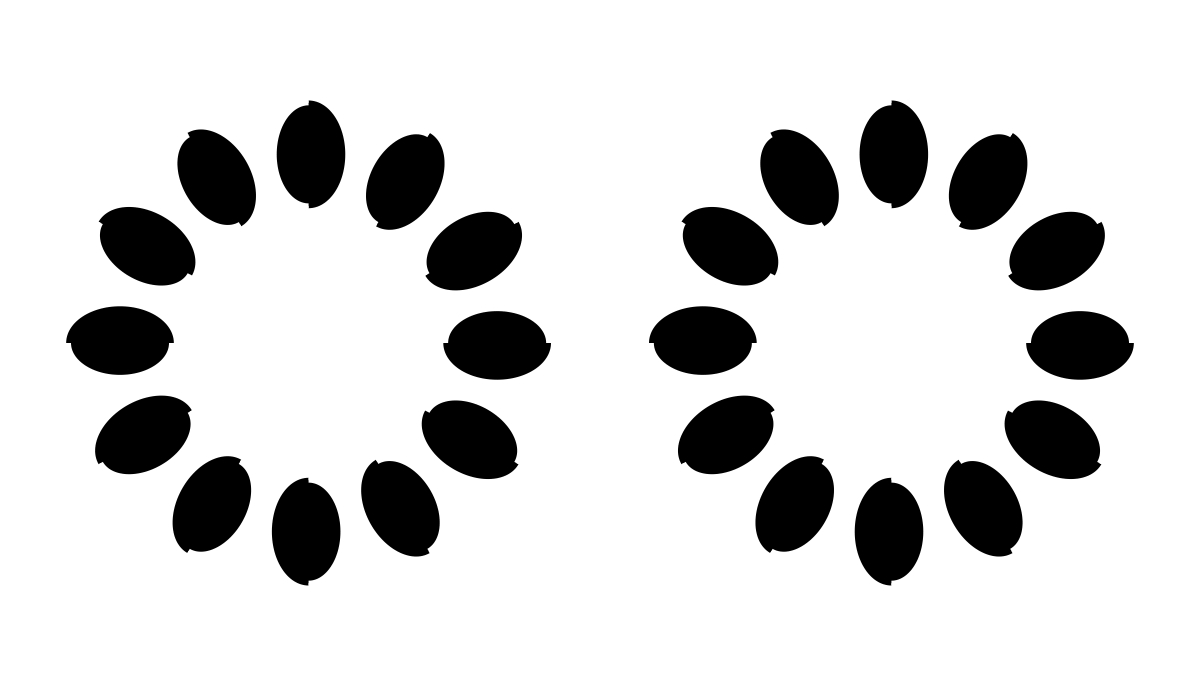
どうやって、「無限運動」を実現するか?
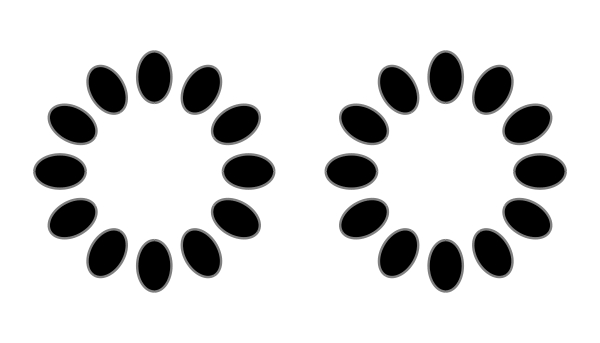
A demo of infinite rotation with reversed phi
(無限回転のリバースファイのデモ)
リングの位置は静止しているが、ずっと時計回りに回転して見える。
Rings appear to rotate clockwise constantly, though they actually do not change the positions.
Copyright Akiyoshi Kitaoka 2020 (April 18)


(200 ms / frame)
A demo of infinite rotation with reversed phi (minimum case)
(無限回転のリバースファイのデモ・4フレーム)
リングの位置は静止しているが、ずっと時計回りに回転して見える。
Rings appear to rotate clockwise constantly, though they actually do not change the positions.
Copyright Akiyoshi Kitaoka 2020 (March 20)

↓

↓

↓


(200 ms / frame)
A demo of infinite rotation with reversed phi (minimum case)・その2
(無限回転のリバースファイのデモ・4フレーム)
(白と黒だけのフレームの時に、灰色のエッジを付けないバージョン)
リングの位置は静止しているが、ずっと時計回りに回転して見える。
Rings appear to rotate clockwise constantly, though they actually do not change the positions.
Copyright Akiyoshi Kitaoka 2020 (March 20)
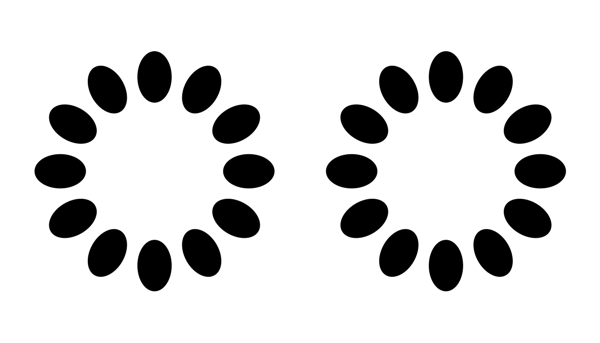
↓
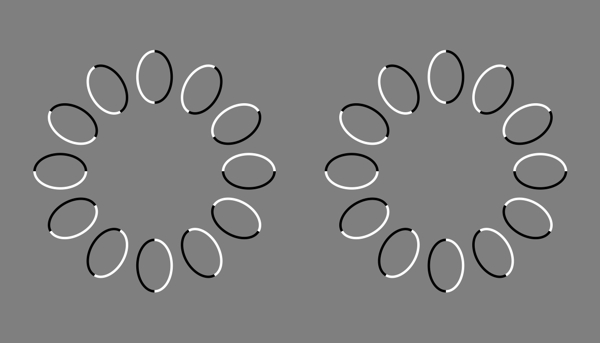
↓
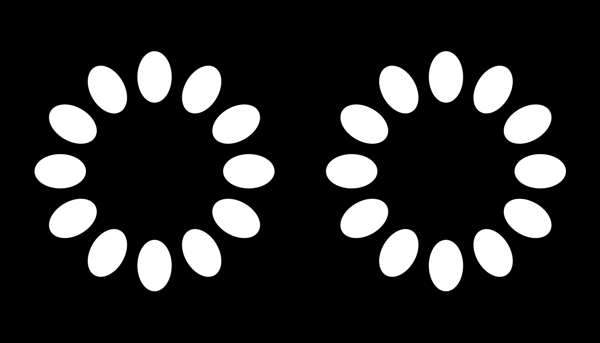
↓
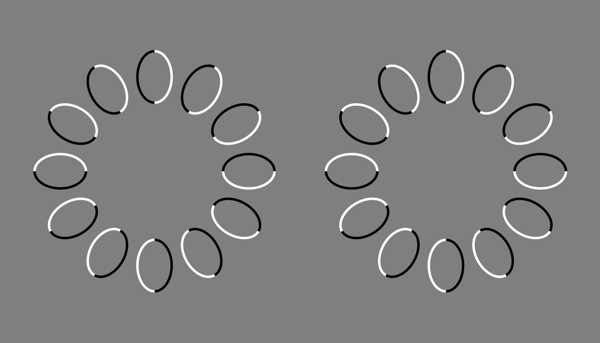

「扉を開けたまま走る電車」
停車中の電車が右に走行するように見える。
Copyright Akiyoshi Kitaoka 2021 (February 9)
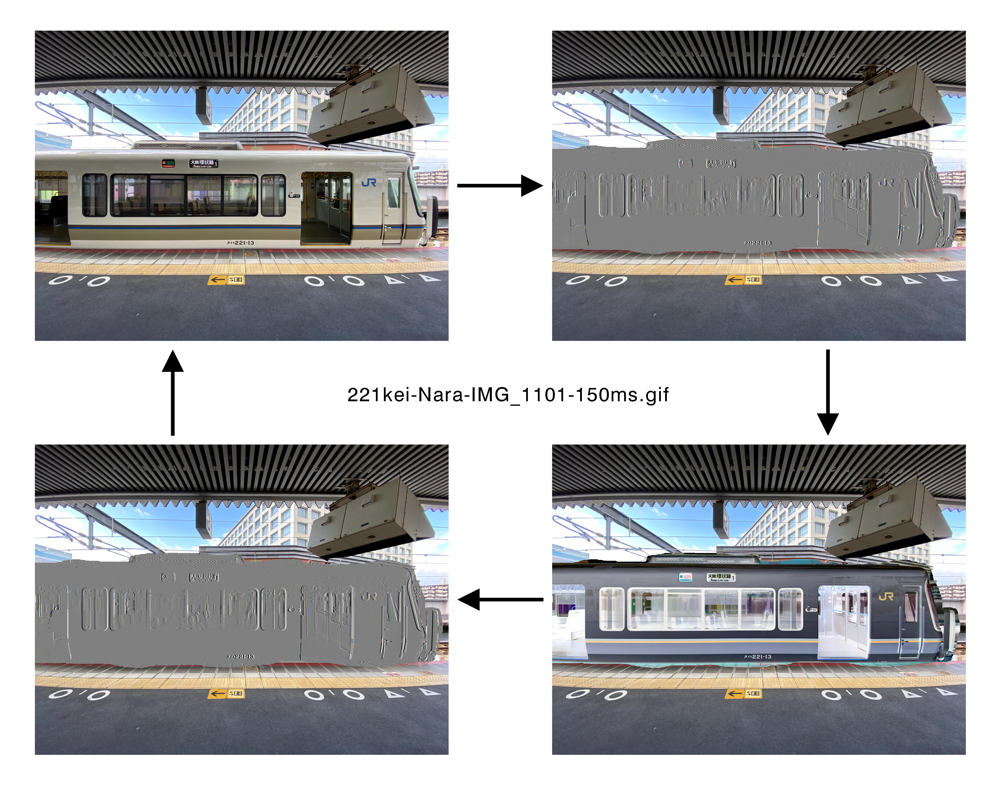
Copyright Akiyoshi Kitaoka 2021 (February 23)
グラフィックソフトを用いた簡単な作り方:「エンボス」ツールを使う方法
.png)
.png)

Copyright Akiyoshi Kitaoka 2021 (February 23)
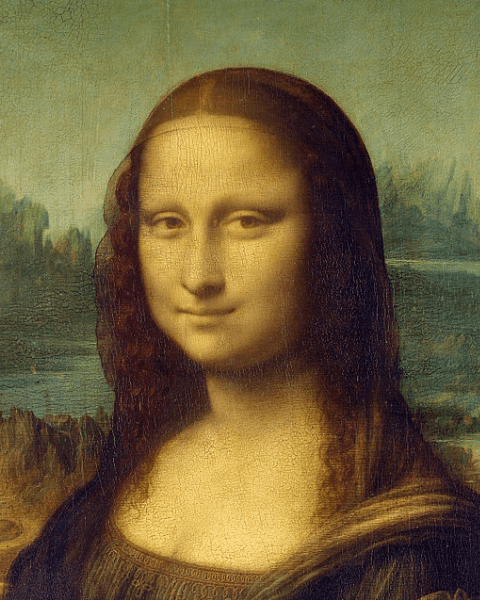
Copyright Akiyoshi Kitaoka 2021 (February 11)
「無限運動錯視」を最初に提案したのは誰か?
普通に考えれば、Mather の four-stroke apparent motion であろうか? 論文は1999年に出ているが、その数年前には学会発表等でデモされていたと思われる(いずれMather先生に伺おうと思います)。
Reference: http://www.georgemather.com/MotionDemos/FourstrokeMP4.html
Mather, G. and Murdoch, L. (1999) Second-order processing of four-stroke apparent motion. Vision Research, 39, 1795-1802.
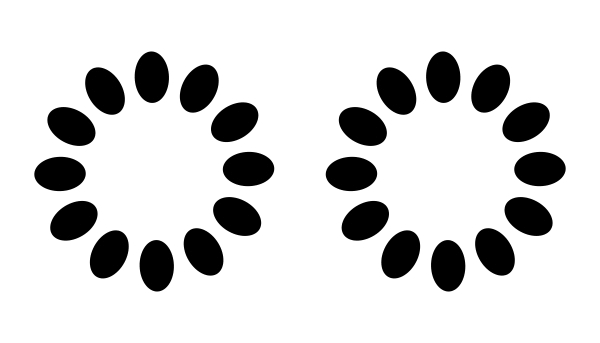
ツイッターで無限運動錯視を有名にしたのは、じゃがりきん氏。この数年のことと思われる(いずれじゃがりきん氏に伺おうと思います)。
スーパー錯視ブラザーズ pic.twitter.com/bLkFhBOCeU
— じゃがりきん (@jagarikin) November 20, 2020
https://nlab.itmedia.co.jp/nl/articles/2011/23/news016.html
筆者の最古の無限運動錯視デモは、2010年4月のようである。本日発表している形態のデモである。
最古の無限運動錯視デモの掲載されているウェブページ → movie7.html (ページの空白部分は、見れなくなった Flash デモがあるところ)
その動画 → Edgetype4strokemotion2.gif (どきついので、閲覧注意)
Anstis のスポーク車輪錯視(illusory totation of a spoked wheel)は、論文は2011年、学会発表は2000年頃らしい。
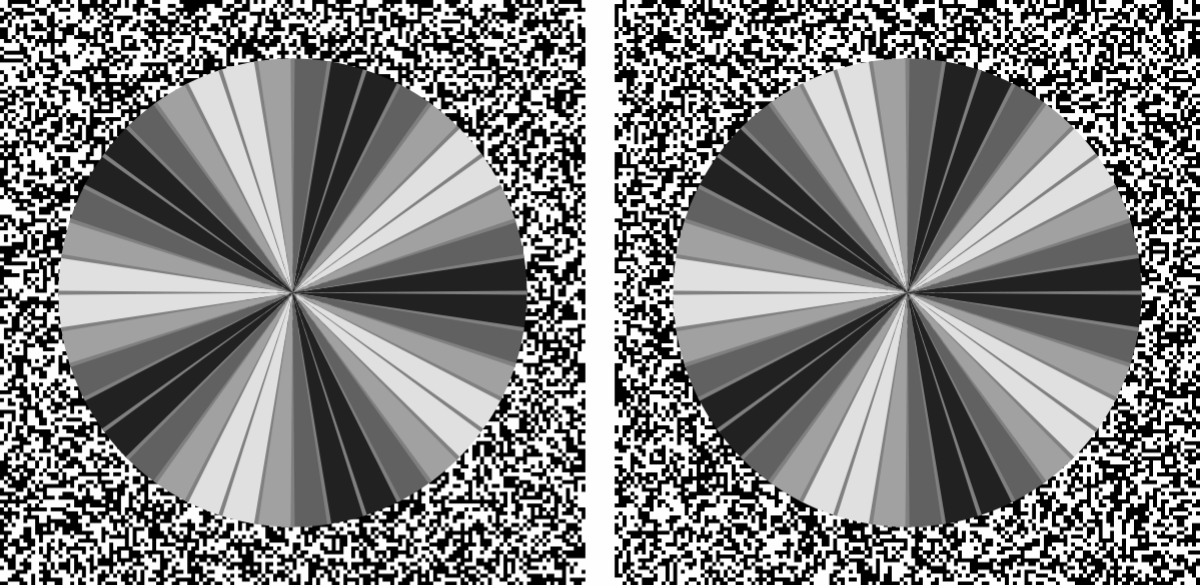
「スポーク車輪錯視(spoked wheel illusion)の再現」
灰色のスポークは静止しているが、背景の5方向の放射パターンが時計回り回転するのに対して、反時計回りに回転して見える。この運動残効は、5方向放射パターンの実運動の反対方向ではなく、灰色のスポークの錯視的運動の反対方向に起こる(Anstis & Rogers, 2011)。
Copyright Akiyoshi Kitaoka 2021 (February 13)
Anstis, S. M. & Rogers, B. (2011). Illusory rotation of a spoked wheel. i-Perception, 2, 720–723. https://doi.org/10.1068/i0483
Reverse Spoke Illusion from Michael Bach https://michaelbach.de/ot/mot-spokes/index.html
For the positive motion aftereffect, see
Nishida, S. & Sato, T. (1992). Positive motion after-effect induced by bandpass-filtered random-dot kinematograms. Vision Research, 32, 1635-1646. https://www.sciencedirect.com/science/article/pii/004269899290156D?via%3Dihub
スポーク車輪錯視には先代があった。「竹内の錯視」(論文は1997年)
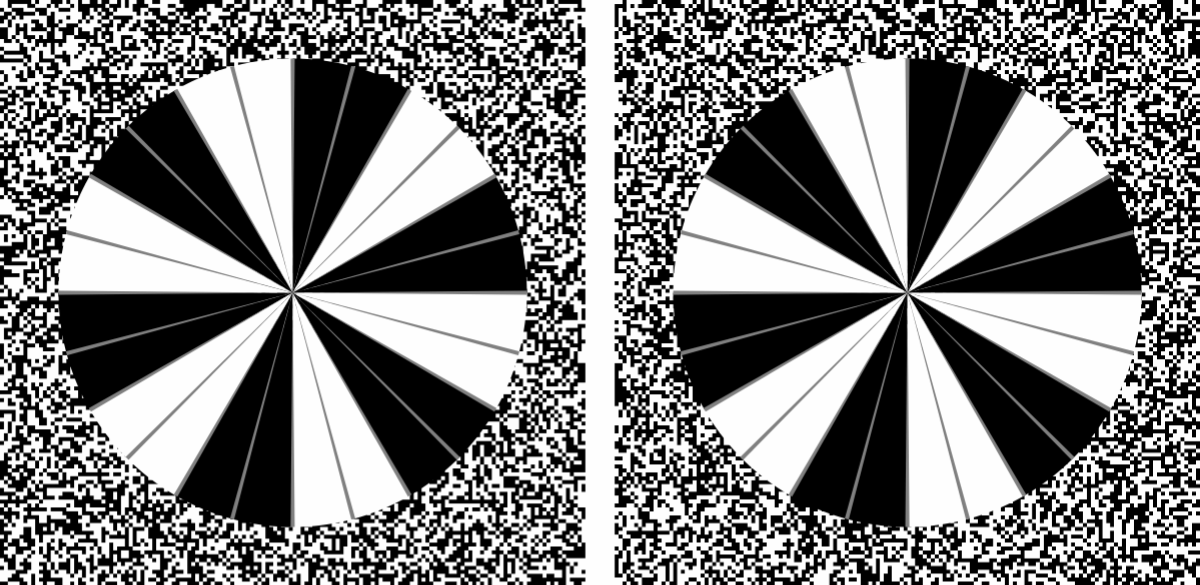
「竹内のカフェウォール錯視の運動類似物錯視の再現」
灰色のスポークは静止しているが、背景の白黒の放射パターンが時計回り回転するのに対して、反時計回りに回転して見える。この運動残効は、放射パターンの実運動の反対方向ではなく、灰色のスポークの錯視的運動の反対方向に起る(Takeuchi, 1997)。
Copyright Akiyoshi Kitaoka 2021 (February 13)
Takeuchi, T. (1997) The motion analogue of the café wall illusion. Perception, 26, 569-584. https://doi.org/10.1068/p260569
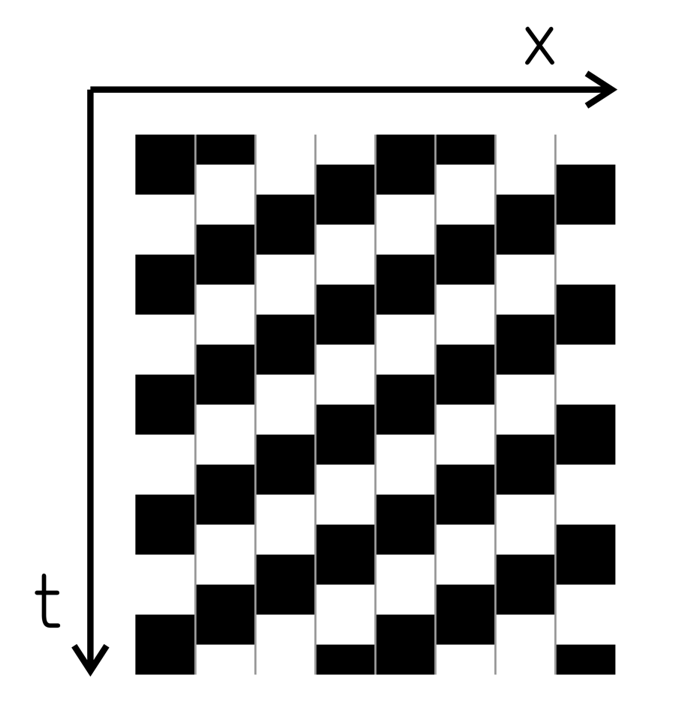
Takeuchi (1997) が指摘した灰色の線が動いて見える錯視とカフェウォール錯視(上図では、垂直の灰色の線が反時計回りに傾いて見える)との類似性
Copyright Akiyoshi Kitaoka 2021 (February 23)

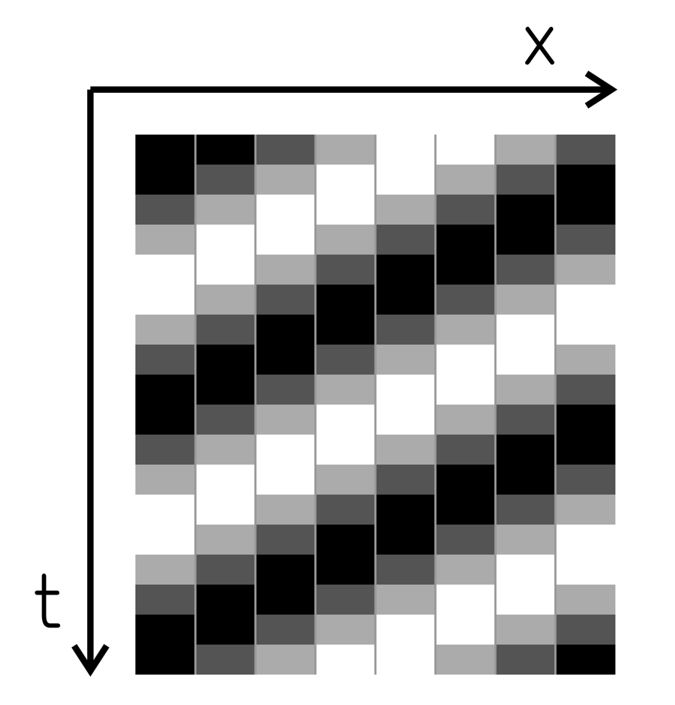
スポーク車輪錯視とカフェウォール錯視に似た錯視(ずれたグラデーションの錯視)(Kitaoka, 1998)(上図では、垂直の灰色の線が反時計回りに傾いて見える)との類似性
Kitaoka, A. (1998). Apparent contraction of edge angles. Perception, 27, 1209-1219. https://journals.sagepub.com/doi/10.1068/p271209
Copyright Akiyoshi Kitaoka 2021 (February 23)

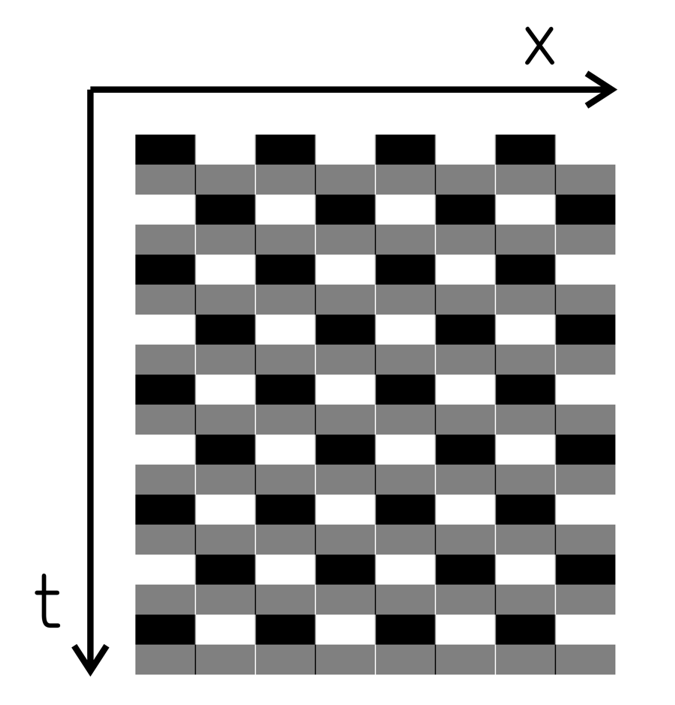
4フレームのリバースファイの「無限運動」と市松模様錯視(Kitaoka, 1998)(上図では、垂直の線分列が反時計回りに傾いて見える)との類似性
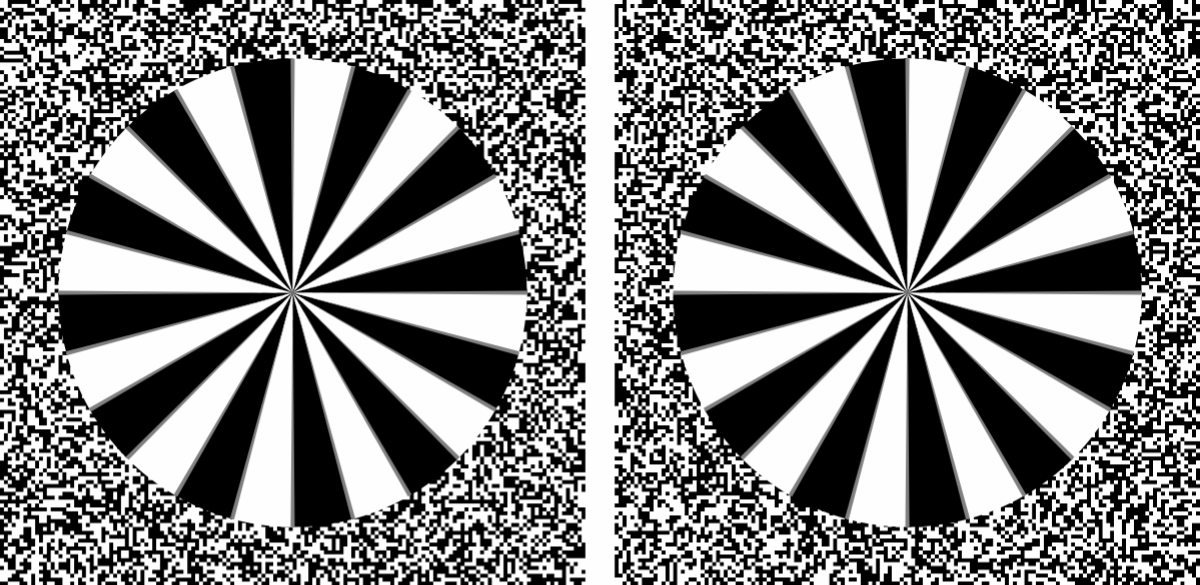
Copyright Akiyoshi Kitaoka 2021 (February 24)

Copyright Akiyoshi Kitaoka 2021 (February 11)
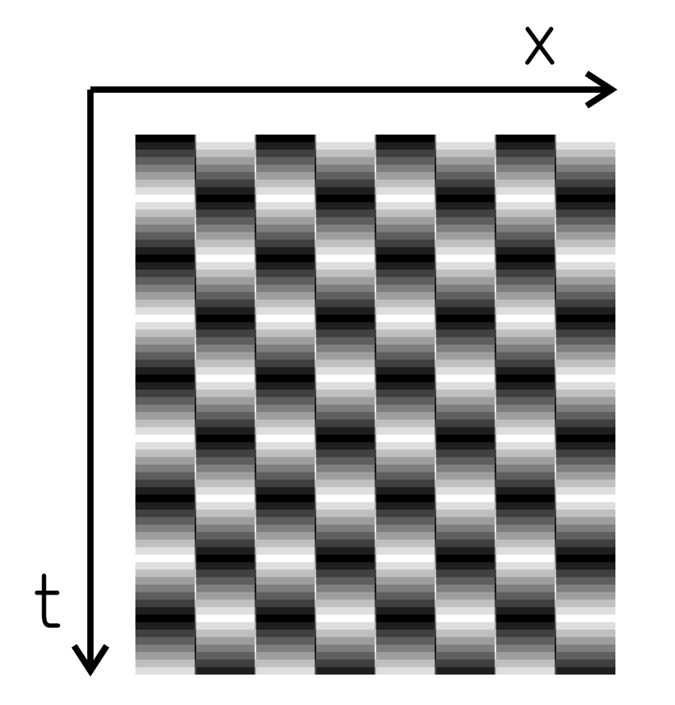
16フレームのリバースファイの「無限運動」と「メタルウォール錯視」(Kitaoka, 2010)(上図では、垂直の輝度勾配のある細い線が反時計回りに傾いて見える)との類似性
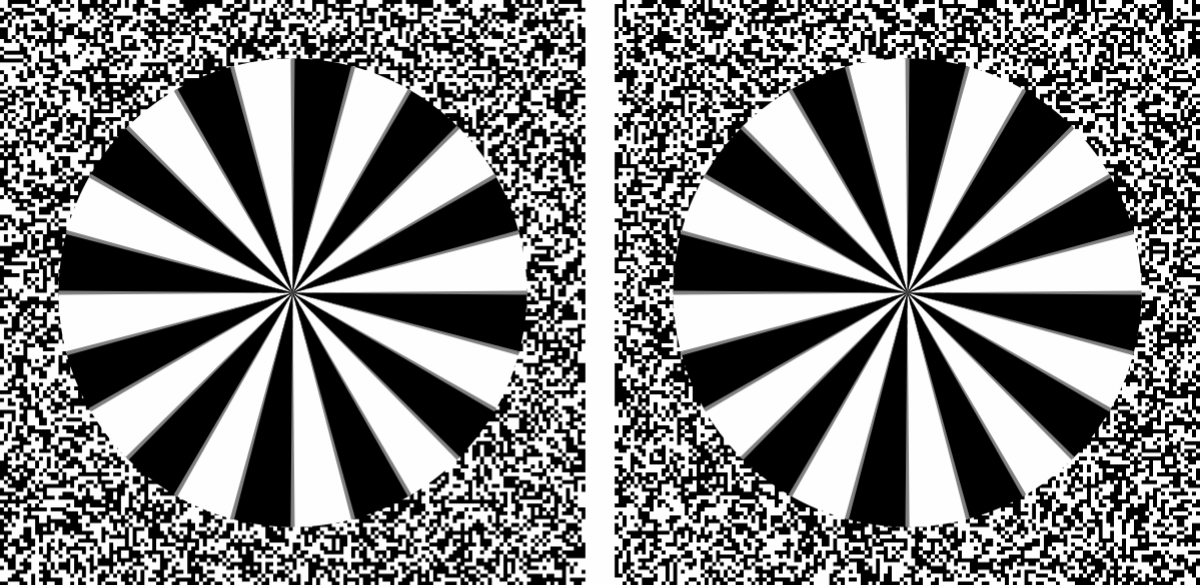
Copyright Akiyoshi Kitaoka 2021 (February 24)
cf.
突然ですが回転させると大きさが変化して見えるリングを考案しました pic.twitter.com/4GgHO7LHeF
— じゃがりきん (@jagarikin) February 19, 2020
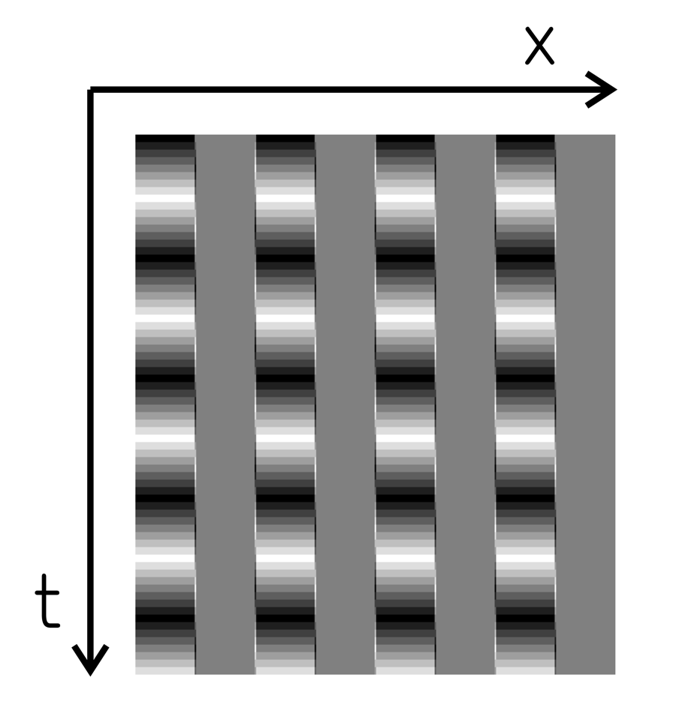
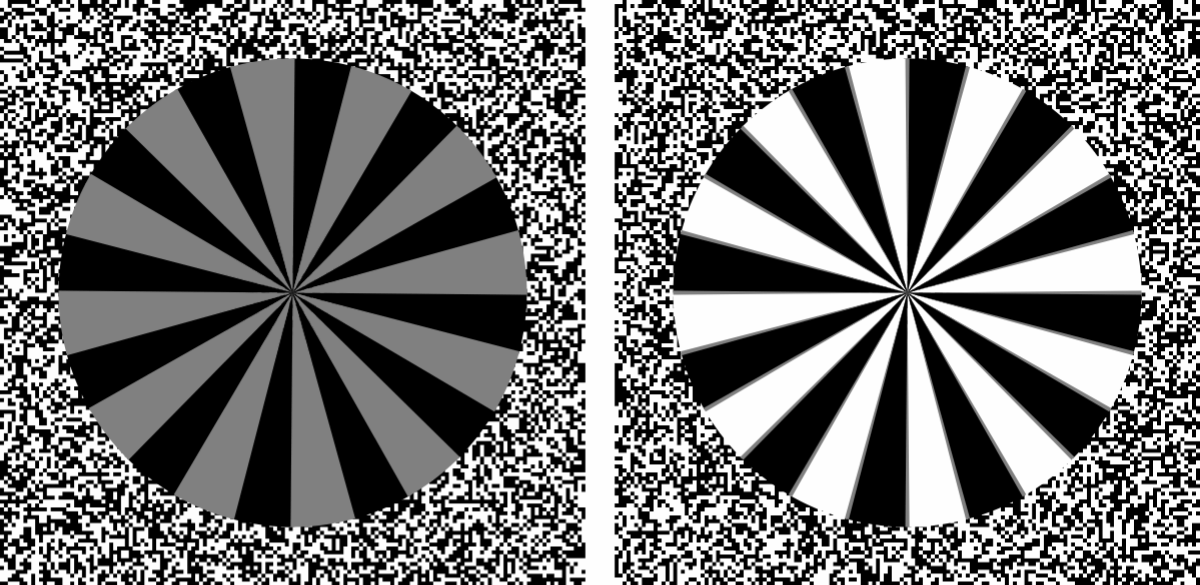
Copyright Akiyoshi Kitaoka 2021 (March 1)
ところで、Mather の 4-stroke apparent motion には、どういう傾き錯視が対応するか?
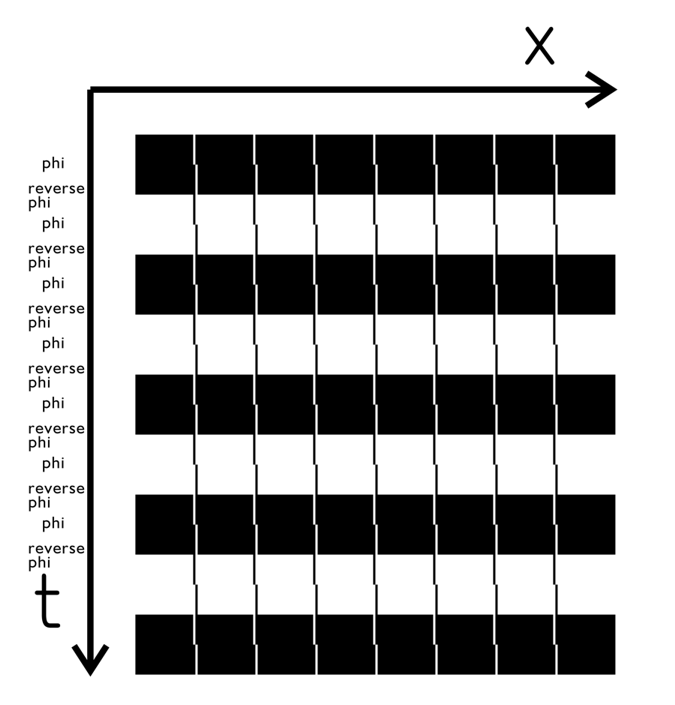
4ストローク運動とフレーザー錯視*との類似性
*この形態は「ずれた線の錯視」(illusion of shfted lines)(Kitaoka, 2007)(上図では、垂直に配列したずれた線分列が反時計回りに傾いて見える)である。
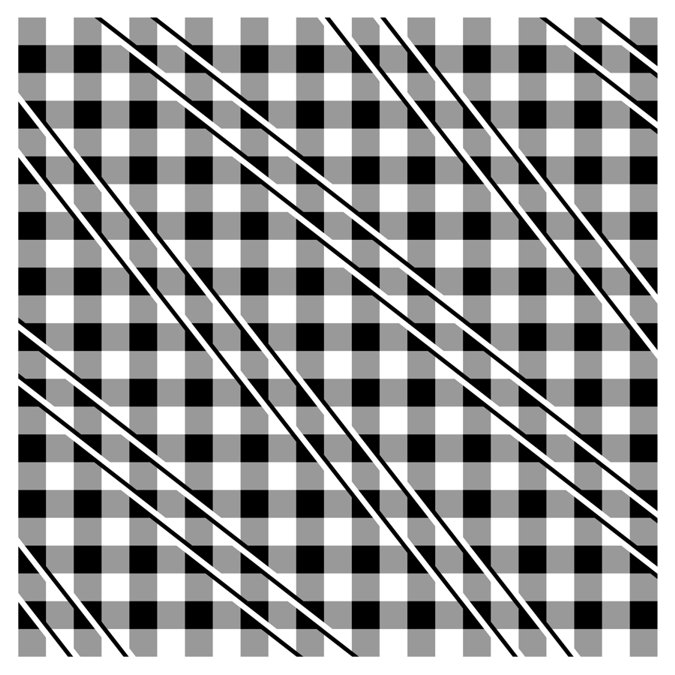
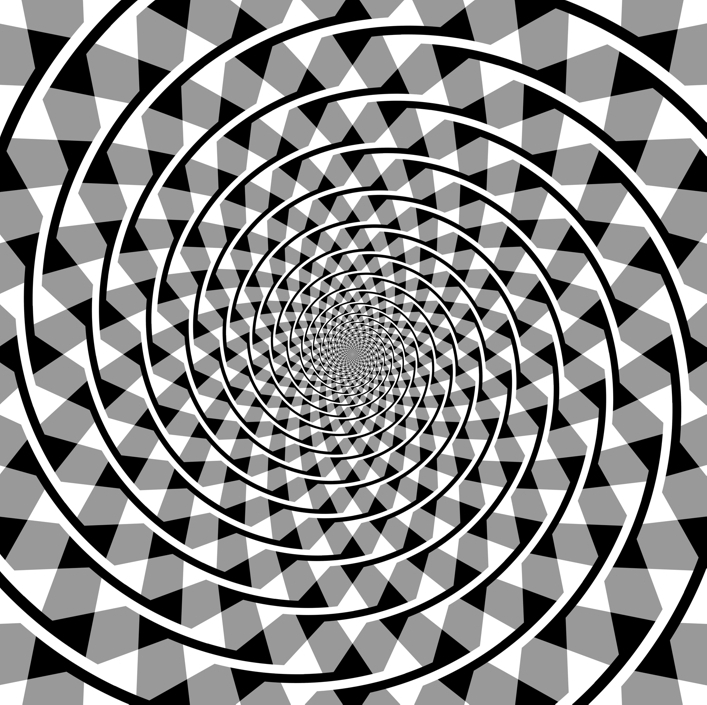
Fraser, J. (1908). A new visual illusion of direction. British Journal of Psychology, 2, 307-320.
https://bpspsychub.onlinelibrary.wiley.com/doi/abs/10.1111/j.2044-8295.1908.tb00182.x
Kitaoka, A. (2007). Tilt illusions after Oyama (1960): A review. Japanese Psychological Research, 49, 7-19.
https://onlinelibrary.wiley.com/doi/10.1111/j.1468-5884.2007.00328.x
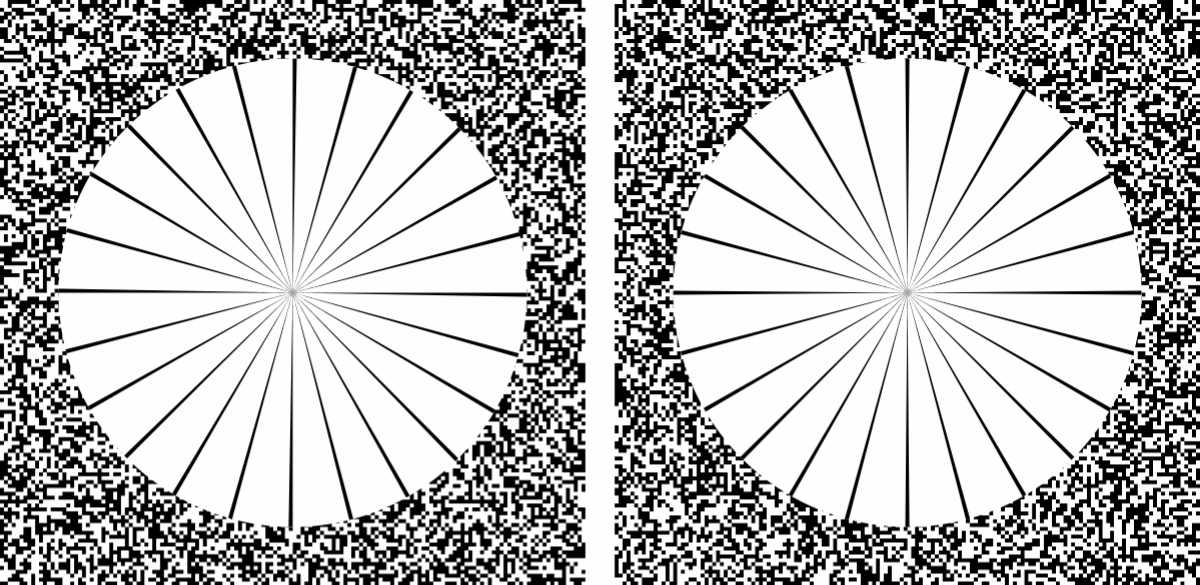
Copyright Akiyoshi Kitaoka 2021 (February 24)
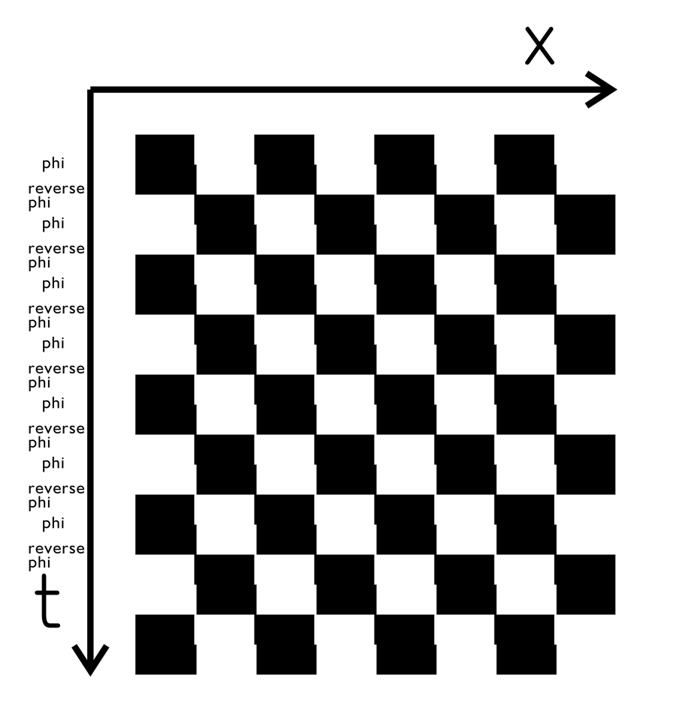
4ストローク運動とフレーザー錯視*との類似性
*この形態は「ずれたエッジの錯視」(illusion of shfted lines)(Kitaoka, 2007)(上図では、垂直に配列したずれたエッジの列が反時計回りに傾いて見える)である。
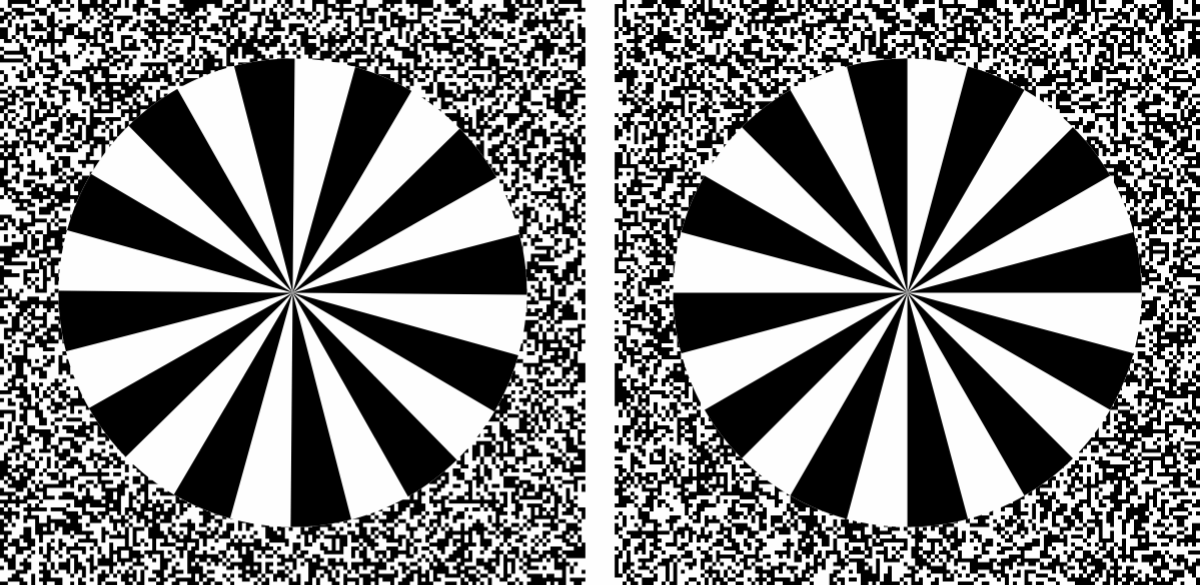
(100 ms / frame)
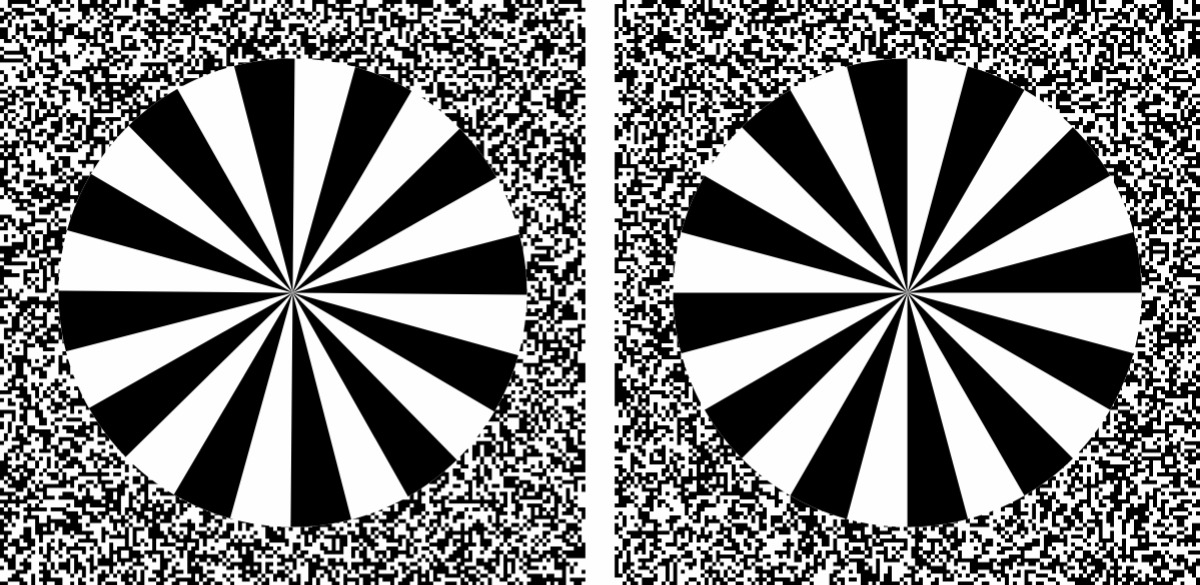
(30 ms / frame)
Copyright Akiyoshi Kitaoka 2021 (March 1)
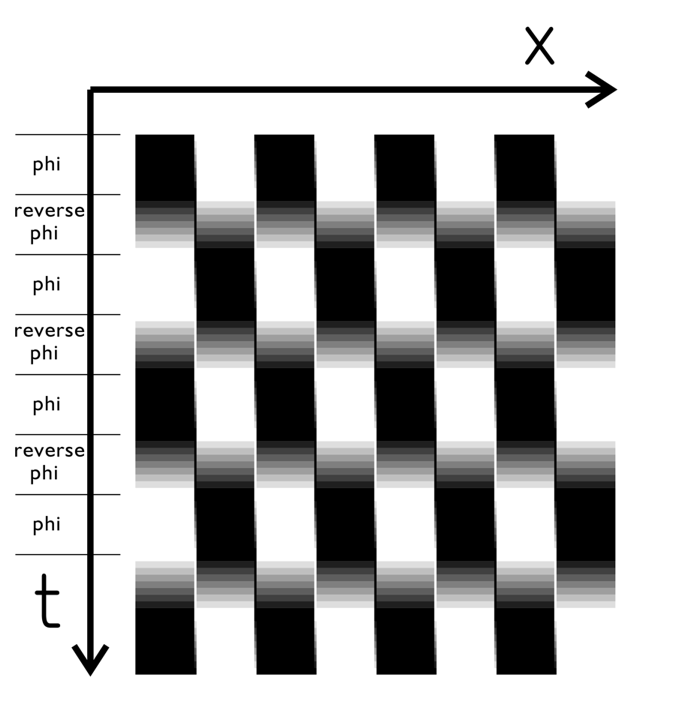
4ストローク運動とフレーザー錯視*との類似性(ファイは9フレーム、リバースファイも9フレーム)
*この形態は「ずれたエッジの錯視」(illusion of shfted lines)とモンタルボ錯視(Montalvo illusion)**(Lavatory Wall illusionともいう)の組み合わせ(上図では、垂直に配列した境界が反時計回りに傾いて見える)である。
**Kitaoka, A. (2007). Tilt illusions after Oyama (1960): A review. Japanese Psychological Research, 49, 7-19.
https://onlinelibrary.wiley.com/doi/10.1111/j.1468-5884.2007.00328.x
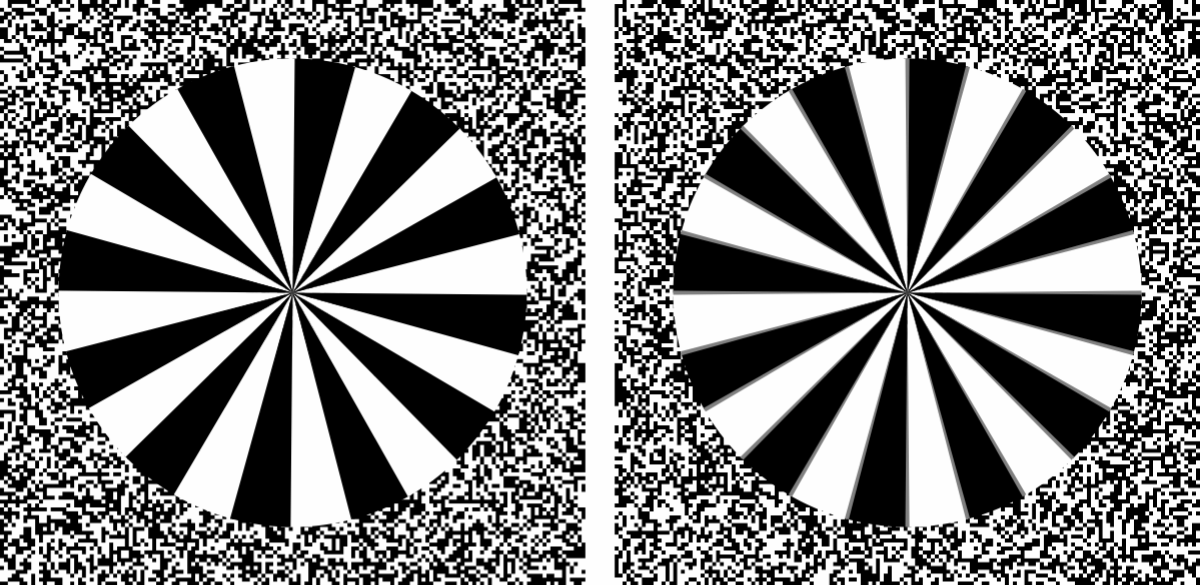
Copyright Akiyoshi Kitaoka 2021 (March 1)
<参考>

(a) and (b): reverse phi; (c) phi
Kitaoka, A. (2006). Configurational coincidence among six phenomena: A comment on van Lier and Csathó (2006). Perception, 35, 799-806. (Figure 6)
https://journals.sagepub.com/doi/10.1068/p5319b
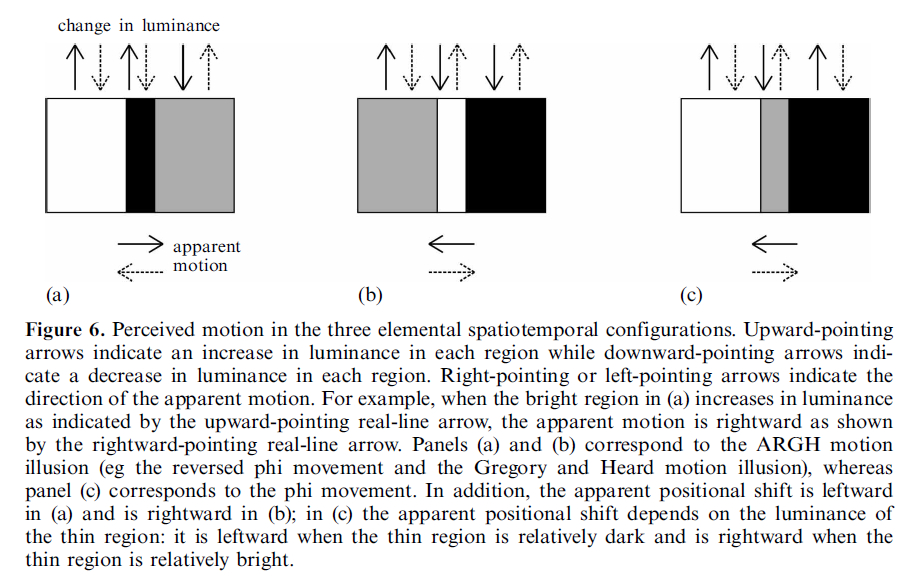
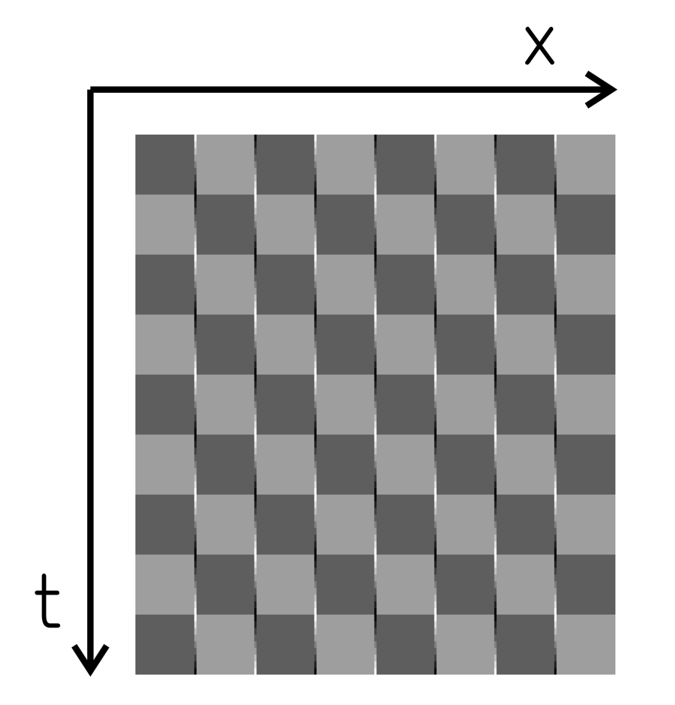
境界の細線の輝度を変えることによる運動錯視と縞模様コードの錯視(Kitaoka, 1998)との類似性(全18フレーム)
Kitaoka, A. (1998). Apparent contraction of edge angles. Perception, 27, 1209-1219. https://journals.sagepub.com/doi/10.1068/p271209
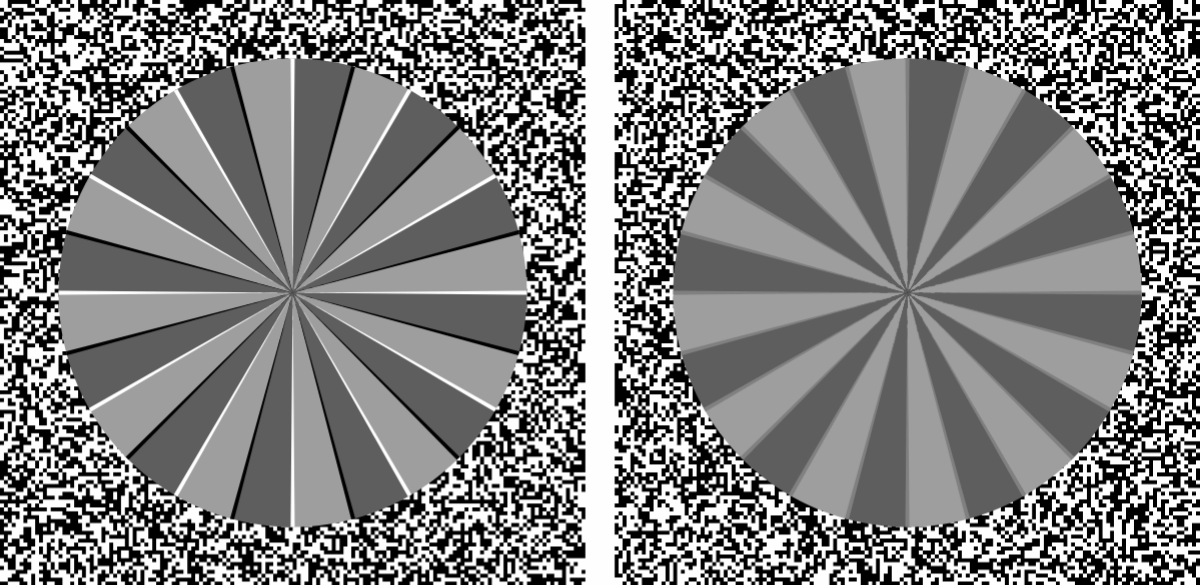
(80 ms / frame)
Copyright Akiyoshi Kitaoka 2021 (March 1)
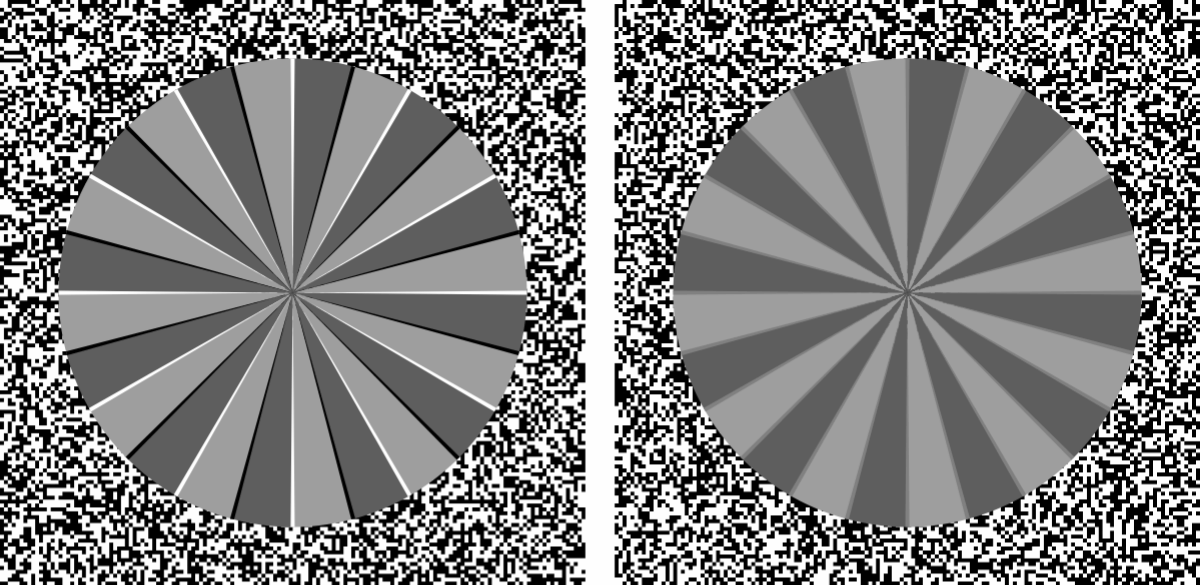
(30 ms / frame)
運動視と傾き錯視が密接に関係する一連の静止画が動いて見える錯視があるが、それらの話題はまた別の機会に。
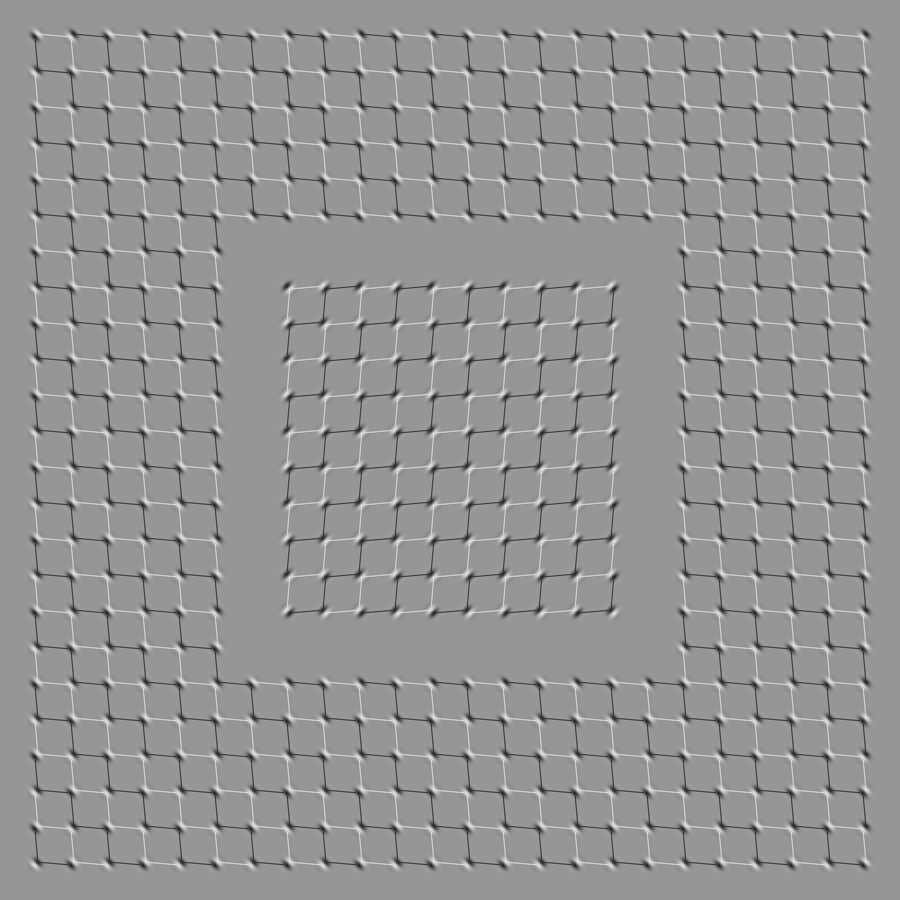
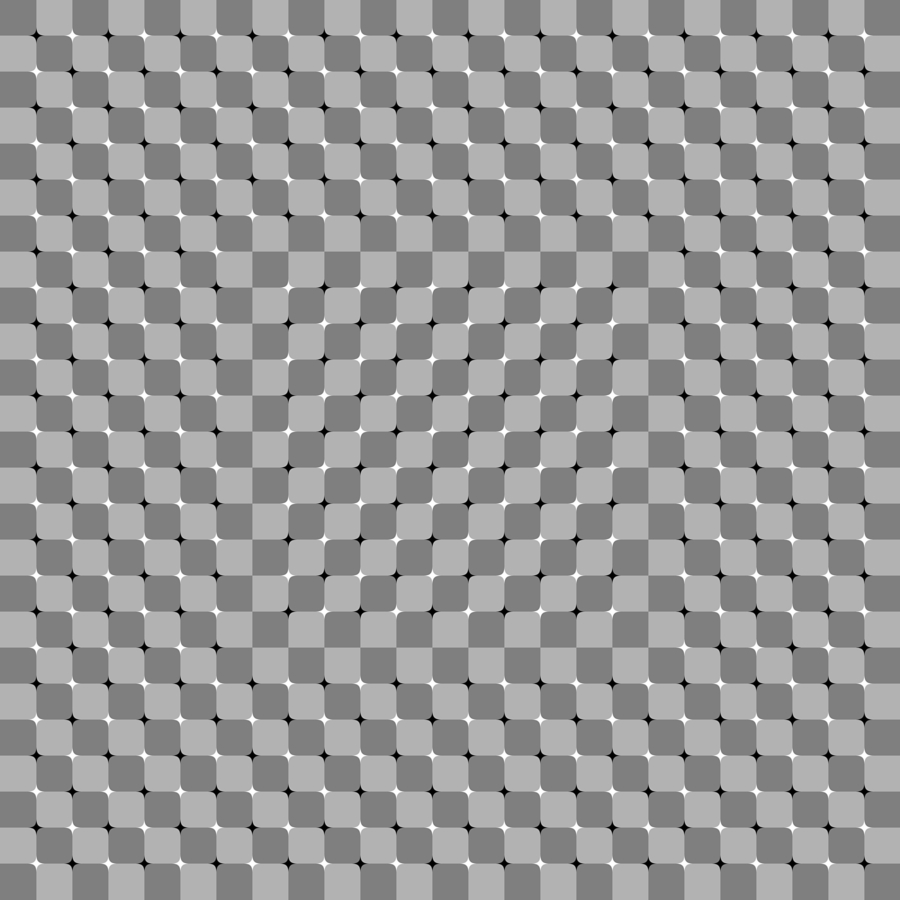
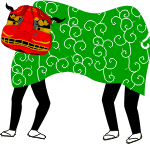 おしまい
おしまい

